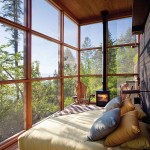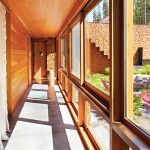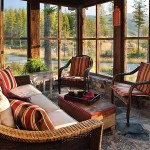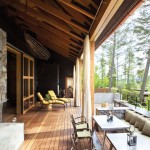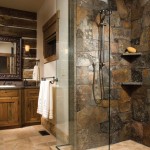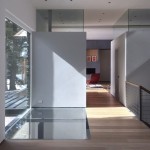CLEARLY A GREAT MATERIAL MOUNTAIN HOMES BENEFIT FROM ADVANCES IN GLASS TECHNOLOGY
by Ann Zimmerman
More mountain homes feature exciting innovative uses of glass, and glass producers are making products that save energy and aesthetically enhance the home in unexpected new ways. So often, as with glass, advances in building materials work hand-in-hand with design as new building materials inspire designs that push the envelope, and bold new designs demand more from the material suppliers and installers. Mountain climate extremes previously limited the use of glass, but now products address strident energy requirements, and artful new uses of glass are appearing that were imagined a hundred years ago but not available.
INDUSTRIALIZING A SKILLED CRAFT
There is something decidedly modern about big glass, although glass windows have been around well before the Roman Empire. It wasn’t until the 17th century that glass became common in homes, and then and into much of the 19th century, glass was hand-blown and expensive. Hand-formed pieces were mounted together in panes for larger windows. The initial glass recipe was pure silica (sand) melted in furnaces at high temperatures along with additions that changed the melting characteristics and qualities of the glass like sodium carbonate, lime, iron, and various metal oxides.
“ CLIENTS WANT SPACES THAT FEEL LIKE PART
OF THIS BEAUTIFUL LANDSCAPE, SO I DESIGN HOMES WITH AMPLE WINDOWS AND SOME WITH RETRACTABLE
GLASS CORNERS.
-STEPHEN DYNIA DYNIA ARCHITECTS
The Industrial Revolution pushed machine-manufactured glass production forward and increased size, uniformity, strength, and affordability. As early as 1914, Bruno Taut created the glass pavilion, marvelous even for today, with a multi-hued prismatic glass dome and a glass-treaded metal staircase. It inspired Paul Scheerbart to write a famous treatise on glass in architecture, Glasarchitektur.
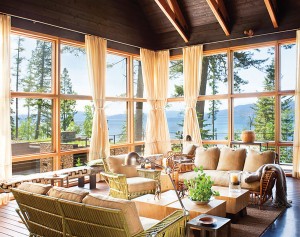
The inspiration took, and glass and metal soon became synonymous with modern architecture. However, products to implement the vision of glass in homes didn’t stand up to the dream. One of the most endearing mid-century modern American homes is glass-walled, the Farnsworth House (1945–51), designed by Ludwig Mies van der Rohe in Plano, Illinois. However, even the iconic Farnsworth home receives criticism for discomfort with winter heat loss and too much summer heat gain.
Improving the thermal qualities of glass isn’t the only obstacle to using glass in homes. As any kid drying the family’s best water glasses knows, glass is fragile, and glass shards are sharp and dangerous. So, how did glass make the leap to becoming not just an accepted building material, but one propelling design to new levels?
NEW WINDOW PRODUCTS PROPEL DESIGN
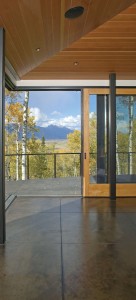
“More than ever, windows are better insulated, more weather- resistant, more durable, and more flexible in design parameters,” observes Nick Gilman, one of the partners of Lee Gilman Builders, Inc., based in Ketchum. “It used to be that windows were limited to sizes, and designers and builders had to adapt to stock sizes. That’s not the case now. Window manufacturers have improved manufacturing processes to accommodate custom window packages, and it is rare to see an upcharge for custom orders. The products we receive are customized to fit the architect’s and designer’s vision and have detailing that is scaled specifically to the window size. Today’s windows are better built, more dimensionally accurate, and we certainly have more options than ever before.”
“You can see the difference in the windows for mountain contemporary homes,” Gilman continues. “Where before windows tended to just be big—big glass with heavy frames, now the windows are simplified in form and lack ornate trim that ruins their scale.”
Gilman recounts a project where his firm couldn’t find exactly what they wanted but was able to work with Matt Barrow of View Point Windows and Sierra Pacific to develop a window with more contemporary detailing. “The manufacturer responded, retooled, and created the new detail configuration within a short turnaround time and with no upcharge. In fact, Sierra Pacific liked the outcome so much, they added it to the product line.”
REACHING ENERGY GOALS THROUGH NEW PRODUCTS
With ordinary windows, up to 87% of heat gain and 49% of heat loss occurs . The glass and window industry responded to the energy crisis in the 1970s, the sustainable green building movement, and Europe’s strict energy standards for greenhouse gas emissions by developing better performing and even bigger windows.
Matt Barrow, owner of View Point in Ketchum, has observed the growth of products for conserving energy. “For high-end homes we are seeing more triple-pane glass called for, and low E-coatings on two or more pieces of glass. Stricter codes and just a desire for higher performance are the reasons for this trend. Products can accomplish down to a .16 U-value, depending on the glazing and selected coatings. Because of our higher elevation here in the Valley, we need breather tubes to equalize the pressure for gas-filled panes. For this reason, it is better to gain performance with coatings rather than gases between the panes that will dissipate over time.”
Under the provisions of the energy analyses, improved insulation or higher efficiency heating and cooling systems must compensate for energy lost through windows and other design components. Steen Sorensen, president of Glass Masters in Ketchum, comments on the demand for increased conservation. “We must meet at least a .32 U-value, and we do so through dual-paned glass with low E-coatings, multiple surfaces, and also solar diffusion. Generally we can circumvent the need for three-paned glass, and we only use it as necessary.”
Sorensen has observed an interesting approach in the Wood River Valley, where glass selections are made appropriate to the directional solar exposure. “Yes, we are using different coatings for different directional faces, like north-facing windows, as we try to dial in more efficiency.”
“I am also seeing some interesting high-performing products utilized in Europe, where there are higher standards, including some plastic and fiberglass substrates. There are good domestic products on the market, as well. We have carried Kolbe & Kolbe for 25 years,” mentions Sorensen.
The overall effect of the new products is the ability to use more glass. “In building designs for a resort marketplace, it’s all about the views,” Gilman sums up. “We can now build a wall of glass with far fewer trade-offs.”
PRODUCTS FOR TRANSPARENCY AND CONNECTIONS
The new transparent look to homes and connections to outdoor living have inspired new products that support the level of architectural design happening in Sun Valley. Steen Sorensen sums up the look for windows, “The trend is less window and more glass. The sight line is important, and a wooden frame adds a certain volume to obstruct views. Instead, steel and aluminum frames are preferred.”
“Absolutely,” agrees Matt Barrow. “The market is for clean, narrow frames made of aluminum, steel, fiberglass, and wood. The steel and aluminum are thermally broken for energy efficiency.”
Nick Gilman points to a recent example,“An architect on a project we were building called for steel-framed windows with an ultra-narrow divider and a low-profile perimeter. It maximizes the glass while maintaining a traditional divided light appearance. The paned dividers gave it a traditional look with a modern twist. This thread of classic continuity is a detail that makes it jump. Trick detailing like this always endures and provides lasting value.”
Matt Barrow says that curved glass, once a rarity, is now available for designs that call for it. “There is also a great product for executing a corner window joining two pieces of glass at a 90-degree angle in one frame for a narrow, clean, good look.”
Both Barrow and Sorensen are installing larger pieces of glass. Where 50 square feet was once the top size available, now pieces approach 200 square feet. “At that size with coatings, it’s a heavy piece of glass to deliver and install,” notes Barrow.
GLASS COMES INSIDE
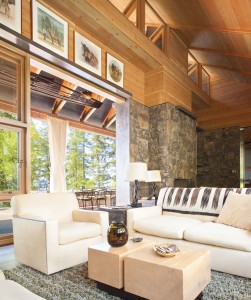
Glass is a useful material for creating transparency and openness in home’s interiors. Some of the applications that push glass to new levels are in stairways, partitions, furniture, and bathrooms.
Again, technology makes glass safer. Anyone who has misdirected a baseball into a traditional (annealed) glass window knows how it shatters into jagged shards. To make it safer, glass can be tempered, laminated, and reinforced. Tempering results from extreme heat and rapid cooling in the manufacturing process so it is harder and more heat-resistant than normal glass, plus it breaks into small ovals instead of sharp shards. Laminated glass adds a durable plastic layer that holds it together when shattered, and reinforced glass has an addition of an impact- resistant material or layer like wire mesh or a coating.
“There are certainly growing uses of glass inside the home,” agrees Sorensen. “There is a movement toward interesting stairways off the entry, and we are building some beautiful glass staircases and railings. Glass stair treads are built in two pieces with a half-inch anti-slide surface combined with a tempered piece to withstand the load. We engineer railings from fully tempered glass, and many of these involve bent, elliptical forms.”
“With open floor plans that connect the kitchen, dining, and living spaces, we are called on to create glass partition walls. Typically, these are top-hung glass walls that can be opaque or clear and serve as sound control in the open space,” adds Sorensen. “Anti-reflective glass is another advance. In a glass space at night, one sees reflections and can’t see out. This glass adds a very different quality.”
“There are also some interesting uses of glass in bathrooms, which we fabricate on site. Products now have iron removed from the glass. Iron is what gives glass a green hue, and when the glass is three-eighths to a half-inch in thickness, the green can be inappropriate with the selected tile and stone. The low-iron type works much better. Also, with a protective baked-on layer of carbon, there is no water spotting or staining. The door can be clean after ten years, and the product carries a ten-year warranty. Painted glass works well for shower walls and as a backsplash in the kitchen.”
Matt Barrow is similarly working on a number of laminated glass stairways, and he also likes low-iron glass in bathrooms to get rid of the green cast. “We have also installed a product in bathrooms where a flip of a switch causes the transparent glass to obscure. It’s the same product used for conference rooms in commercial applications.”
Products that appeal to Nick Gilman are panels created by 3form in Salt Lake City. “They are great products. A transparent material is inlayed with beautiful natural elements such as actual grass. They work well as separations, partitions in a powder room, or sliding partitions in an open floor plan. Modern materials such as these allow us to maintain the open space of the architecture and transmit natural light.”
“ WE USE LIFT AND SLIDE DOORS EXTENSIVELY IN THIS AREA BECAUSE ARCHITECTURALLY THEY ADD SO MUCH MORE
TO THE SPACE.
-BRAD REEDSTROM BIGFORK BUILDERS
“I also like the effect of combining LED lighting systems with glass. We recently used this detail for the remodel of the Power House Pub and Bike Shop. It has application for homes to introduce a sense of movement and change when you manipulate the color of the LED lights,” adds Gilman.
With the paramount demand for unobstructed views and connections to the outdoors and outdoor living, glass doors for these passages serve an important need. Perhaps one of the most welcomed new products for Wood River homes are lift-and-slide doors. “The old-school sliders only opened three feet and the frames were visible threshold restraints. Now four big panes of glass lift and slide together to unite the exterior with the interior of the home,” describes Gilman.
“They are thicker, so they aren’t as limited in size,” adds Matt Barrow. “They are also available in safety glass, which is useful for homes built along golf courses. More people are using tempered glass, too, because of concern about fires.”
There have been enormous advances in glass in a short period of time. Manufacturers claim various types of safety glass can resist earthquakes, hurricanes, bullets, bombs, explosions, and forced entry. The old adage no longer seems to hold that people in glass houses shouldn’t throw stones.
With new products being introduced, there are more innovative uses of glass to come both inside and out for aesthetics, transparency to the views, and exciting modernity. The century-old vision for glass as a modern building material has become technically possible; the glass industry has delivered.

